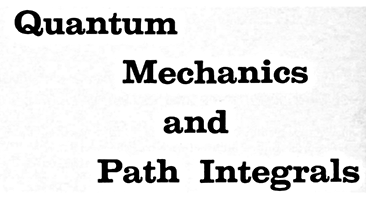
\(\)
Problem 6-11
Suppose the diatomic molecules are oriented in a random fashion. Show that the electron scattering averaged over a group of such molecules is proportional to
\begin{equation}
f^{2}_{A}+f^{2}_{B}+2f_{A}f_{B}\frac{\sin q\, d/\hbar}{q\, d /\hbar}
\end{equation}
f^{2}_{A}+f^{2}_{B}+2f_{A}f_{B}\frac{\sin q\, d/\hbar}{q\, d /\hbar}
\end{equation}
How can this result be generalized to the case of polyatomic molecules?
(解答例) ランダムに配向した一群の分子による電子散乱の平均をとるには, 運動量移行 \(\mathbf{q}\) の方向を極座標系の \(z\) 方向とした全立体角について, 問題 6-10 で得られた量 \(|K^{(1)}|^{2}\) の平均を求めてやればよい.従って,
\begin{align}
\def\mb#1{\mathbf{#1}}
\def\reverse#1{\frac{1}{#1}}
\overline{|K^{(1)}|^{2}}&=\reverse{4\pi}\int |K^{(1)}|^{2}\,d\Omega
=\reverse{4\pi}\int_0^{2\pi}d\phi \int_0^{\pi}\sin\theta\,d\theta\,|K^{(1)}|^{2}\\
&=\reverse{2}\int_0^{\pi}\left\{f_A^{2}+f_B^{2}+2f_Af_B\cos\left(\frac{q\,d\cos\theta}{\hbar}\right)\right\}\,\sin\theta\,d\theta\\
&=\reverse{2}(f_A^{2}+f_B^{2})\int_0^{\pi}\sin\theta\,d\theta
+f_Af_B\int_0^{\pi}\cos\left(\frac{q\,d\cos\theta}{\hbar}\right)\,\sin\theta\,d\theta\\
&=f_A^{2}+f_B^{2}+f_Af_B\int_0^{\pi}\cos\left(\frac{q\,d\cos\theta}{\hbar}\right)\,\sin\theta\,d\theta
\tag{1}
\end{align}
\def\mb#1{\mathbf{#1}}
\def\reverse#1{\frac{1}{#1}}
\overline{|K^{(1)}|^{2}}&=\reverse{4\pi}\int |K^{(1)}|^{2}\,d\Omega
=\reverse{4\pi}\int_0^{2\pi}d\phi \int_0^{\pi}\sin\theta\,d\theta\,|K^{(1)}|^{2}\\
&=\reverse{2}\int_0^{\pi}\left\{f_A^{2}+f_B^{2}+2f_Af_B\cos\left(\frac{q\,d\cos\theta}{\hbar}\right)\right\}\,\sin\theta\,d\theta\\
&=\reverse{2}(f_A^{2}+f_B^{2})\int_0^{\pi}\sin\theta\,d\theta
+f_Af_B\int_0^{\pi}\cos\left(\frac{q\,d\cos\theta}{\hbar}\right)\,\sin\theta\,d\theta\\
&=f_A^{2}+f_B^{2}+f_Af_B\int_0^{\pi}\cos\left(\frac{q\,d\cos\theta}{\hbar}\right)\,\sin\theta\,d\theta
\tag{1}
\end{align}
このとき 第 3 項の積分は, 変数変換 \(\cos\theta=x\) とするならば,
\begin{align}
\int_0^{\pi}\cos\left(\frac{q\,d\cos\theta}{\hbar}\right)\,\sin\theta\,d\theta
&=\int_{-1}^{1}\cos\left(\frac{q\,d}{\hbar}x\right)\,dx
=\left[\reverse{q\,d/\hbar}\sin\left(\frac{q\,d}{\hbar}x\right)\right]_{-1}^{1}\\
&=2\frac{\sin(q\,d/\hbar)}{q\,d/\hbar}
\tag{2}
\end{align}
\int_0^{\pi}\cos\left(\frac{q\,d\cos\theta}{\hbar}\right)\,\sin\theta\,d\theta
&=\int_{-1}^{1}\cos\left(\frac{q\,d}{\hbar}x\right)\,dx
=\left[\reverse{q\,d/\hbar}\sin\left(\frac{q\,d}{\hbar}x\right)\right]_{-1}^{1}\\
&=2\frac{\sin(q\,d/\hbar)}{q\,d/\hbar}
\tag{2}
\end{align}
よって式 (1) は次となる:
\begin{align}
\overline{|K^{(1)}|^{2}}&=f_A^{2}+f_B^{2}+f_Af_B\times 2\frac{\sin(q\,d/\hbar)}{q\,d/\hbar}\\
&=f_A^{2}+f_B^{2}+2f_Af_B\frac{\sin(q\,d/\hbar)}{q\,d/\hbar}
\tag{3}
\end{align}
\overline{|K^{(1)}|^{2}}&=f_A^{2}+f_B^{2}+f_Af_B\times 2\frac{\sin(q\,d/\hbar)}{q\,d/\hbar}\\
&=f_A^{2}+f_B^{2}+2f_Af_B\frac{\sin(q\,d/\hbar)}{q\,d/\hbar}
\tag{3}
\end{align}
この結果を一般化して \(n\) 個の原子からなる分子の場合を考える.まず式 (6-57) に相当する式は \(\mb{r}_j=\mb{r}-\mb{j}\) として次となる:
\begin{equation}
K^{(1)}=\sum_{j=1}^{n}e^{i\mb{q}\cdot\mb{r}_j/\hbar}
\tag{4}
\end{equation}
K^{(1)}=\sum_{j=1}^{n}e^{i\mb{q}\cdot\mb{r}_j/\hbar}
\tag{4}
\end{equation}
また問題 6-10 の 2 原子分子の場合の結果は次であった:
\begin{equation}
|K^{(1)}|^{2}=f_A^{2}+f_B^{2}+2f_Af_B\cos(\mb{q}\cdot\mb{d}/\hbar)
\tag{5}
\end{equation}
|K^{(1)}|^{2}=f_A^{2}+f_B^{2}+2f_Af_B\cos(\mb{q}\cdot\mb{d}/\hbar)
\tag{5}
\end{equation}
この式の形から類推して, それを \(n\) 個の場合に一般化した式は次のような形になるであろう:
\begin{align}
\big|K^{(1)}\big|^{2}&=\left|\sum_{j=1}^{n}e^{i\mb{q}\cdot\mb{r}_j/\hbar}\right|^{2}
=\left(\sum_{j=1}^{n}e^{i\mb{q}\cdot\mb{r}_j/\hbar}\right)^{*}\times
\left(\sum_{k=1}^{n}e^{i\mb{q}\cdot\mb{r}_k/\hbar}\right)\\
&=\sum_{j=1}^{n}f_j^{2}+2\sum_{j=1}^{n-1}\sum_{k>j} f_j f_k
\cos\frac{\mb{q}\cdot(\mb{r}_j-\mb{r}_k)}{\hbar}
\tag{6}
\end{align}
\big|K^{(1)}\big|^{2}&=\left|\sum_{j=1}^{n}e^{i\mb{q}\cdot\mb{r}_j/\hbar}\right|^{2}
=\left(\sum_{j=1}^{n}e^{i\mb{q}\cdot\mb{r}_j/\hbar}\right)^{*}\times
\left(\sum_{k=1}^{n}e^{i\mb{q}\cdot\mb{r}_k/\hbar}\right)\\
&=\sum_{j=1}^{n}f_j^{2}+2\sum_{j=1}^{n-1}\sum_{k>j} f_j f_k
\cos\frac{\mb{q}\cdot(\mb{r}_j-\mb{r}_k)}{\hbar}
\tag{6}
\end{align}
従って, この式 (6) と式 (5) との比較から, 式 (3) を一般化したものは次となることは明らかであろう:
\begin{equation}
\overline{\big|K^{(1)}\big|^{2}}=\sum_{j=1}^{n}f_j^{2}+2\sum_{j=1}^{n-1}\sum_{k>j}f_j f_k
\frac{\sin (q\, d_{jk}/\hbar)}{q\, d_{jk}/\hbar}
\tag{7}
\end{equation}
\overline{\big|K^{(1)}\big|^{2}}=\sum_{j=1}^{n}f_j^{2}+2\sum_{j=1}^{n-1}\sum_{k>j}f_j f_k
\frac{\sin (q\, d_{jk}/\hbar)}{q\, d_{jk}/\hbar}
\tag{7}
\end{equation}
ただし \(d_{jk}=|\mb{r}_j-\mb{r}_k|\) である.
